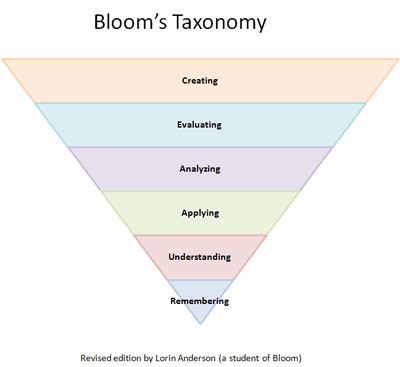Online Teaching Tip #17 – Surprise Your Students by Noticing
Surprise Your Students by Noticing
Imagine that you checked your inbox today to find an unexpected email. It's from a friend whom you had a conversation with last week and they wrote, "Insert your name, I was just thinking about our conversation last week and something that you said."
They would immediately have your attention. You'd be thinking, "Something I said was important? I wonder what it was." Your friend goes on to tell you exactly what you said, and the impact those words had on her. They end with a question for you.Now you feel even more important!
This kind of emails tells us 1) That our friend was listening, and 2) They value our perspective.
Those are two things your students really need, and they are two things that can nurture the learning process.
So, try it. Look over a couple assignments or discussions, then send a few of your students a personal email pointing out something they wrote. It can be brief, just one sentence. Follow that up with a question, one that seeks to get more from their perspective. You can do this in your discussions and in your email correspondence.
Some succinct and effective responses you could use:
1. Tell me more about this idea. (I guess that's not a question :)
2. How does your idea relate to the reading you have been doing for the course this week?
2. Unpack that for me; I want to hear more about that.
Online Teaching Tip #16 – Your Core Question for Online Discussions
The One Question that Drives How You Facilitate Online Discussion
Here's the question: How can I move this student (or group of students) to the next level?
You're probably thinking, "Aaron, where are you getting these 'levels'." I'm getting them from Mr. Bloom, and his associates (see Bloom's Updated Taxonomy). Their taxonomies will provide you with grid to 1) Determine what level your student is on, and 2) Think through what would move them to the next level.
Example #1 - Cognitive Focus
If the discussion has a more cognitive focus, I'll ask myself, "How could I move this student from understanding the content to applying it to a scenario?" or "How could I move this group of students from analyzing the data to evaluating its validity?"
Example #2 - Affective Focus
If your discussion goals are more affective, dealing with learners' values and emotional responses to the content, then get familiar with the Affective Taxonomy. This taxonomy is more difficult for teachers to grasp, but it's an essential tool for learning. Here's a great resource created by the National Science Foundation: Affective Domain Page.
When addressing the affective domain, I'll ask myself, "How can I help this student to become aware of the values latent in his response?" or "How can I challenge her to consider the values that undergird the opposing viewpoint?"
That's just a few examples of how we can use one question to move our learners to the next level in online discussions.
Online Teaching Tip #15 – Your Role as Discussion Facilitator
Your Role as Online Discussion Facilitator
It can be difficult to feel out your role in online discussions. In my years of teaching online, I've come to see that the discussions don't need managed, but they do need our leadership. Here are three different strategies you can use to take that leadership role with your online discussions.
1. Ask For More. This is particularly effective in the early stage of a discussion. Write a simple response asking a student to elaborate on their thoughts. Ask them to "Tell me more about..." or "Explain what you meant by..."
2. Resource. Give your students web links or textbook page numbers to help them explore the topic. They are new to the subject matter and do not always know how to find quality information about the topic.
3. Challenge. I like to take an indirect approach to this, especially as my students are getting familiar with me and still growing to trust me (which can take longer online). I'll ask, "Suppose that a person were to disagree with your statement, '...', How would you respond to them?" I enjoy playing the devil's advocate, but I'll often wait until later in the semester to do so directly.
These are the three foundational strategies that I'd recommend you add to your facilitation toolbox.
Online Teaching Tip #14 – Some Criteria for Online Discussions
Some Criteria For Online Discussions
In Online Teaching Tip #13, I explained how using the wrong grading criteria for online discussions can kill student interaction. Now I'd like to answer the question, "What criteria should I use when grading my online discussions?"
1. First get the big picture. Ask yourself what the learning goal is for your discussions or a particular discussion. Your criteria should correspond to your learning goals.
2. Require Interaction. How many posts/responses will you require?
3. What should characterize learner interactions? Critical thinking? Problem solving? Integration? Be sure to explain what you mean to your students when using those criteria.
4. Timeliness. You'll need deadlines and timeline. How long will your discussion last? Within that discussion, when do posts and responses need to be made in order for the discussion to have a sense of continuity? Deduct for late posts. Discussions without post dates are like a shark with no teeth.
5. What about spelling and grammar? Don't major on it; minor on it. I tell my students that there will be a 20% deduction for any posts wherein the spelling and grammar are of such a low quality that they make it difficult to read and understand their posts. If I'm having to reread a sentence three times, or trying to divine the meaning of their posts, then we have a problem. This would be the same criteria I would use in a face-to-face discussion.
Online Teaching Tip #13 – Discussions are Not Essays
Online Discussions are Not Essays
This can be a hard one. Here's why.
As teachers, we are used to grading text-based documents a certain way. And those documents, research papers, essays, and the like, need to follow a very clear line of thought. They need to be free of spelling and grammatical errors. Citations are are critical for both academic integrity and validating the information (the truth).
But the online discussion, though it is text-based, is a different animal altogether, and should be treated as such. It is a discussion. Discussions follow a line of thought, but it is often circuitous. There are interjections and rabbit trails, because it is dynamic, and because it's a process of discovery. Imagine that you are in a discussion and someone corrects your use of English, or requires you to provide a citation (you may know people who actually do this--we avoid conversations with them). Such criteria stifles discussion. And when used, students stop sharing their opinions--a necessary initial phase of any discussion. They revert to writing mini-essays, and the emerging interaction between students withers on the vine.
In Sum: Using the wrong criteria to assess online discussions can be like an early frost--it'll kill your discussions.
In future tips, I'll spell out some criteria that will help you to both make your online discussions true discussions and help you hold your students to a standard of quality in their online interaction.
Online Teaching Tip #12 – Create Mystery
Why are all these people (even kids) lying across the railroad tracks?
 A death wish? No. You'd observe the presence of the kids and the number of people, then you'd rule that out.
A death wish? No. You'd observe the presence of the kids and the number of people, then you'd rule that out.
It's warm? Nope.
They are trying to hear when the train will be coming?
Better guess, but no.
I've used this exercise to teach my students about the role of observation in literature and art. But creating mystery (or generating inquiry) can be an effective approach to your online communications.
We touched on this in Online Teaching Tip #10 about drafting effective subject lines. We can either give our students rationale--Why You Should Read This--or we need to generate interest through mystery. Here are a couple steps that may help you get started:
1.
Before sending out that weekly email, ask yourself, "What's the one thing I want them to understand this week?" The answer to that question is your starting point. Then ask,"How can I create a sense of inquiry, mystery, or exploration around this concept?" That will lead you in the right direction.
2.
Ask your students for a clear response. Should they click, reply, observe, post, research, be the first to..., watch, find, record--you get the point. Questions and mystery are great, but your students need some call to action to get them to pursue the learning concepts you've set before them.
An entire field of educational theory has been devoted to this basic concept. To find out more, check out New York Public Media's site devoted to Inquiry Based Learning.
Online Teaching Tip #11 – Why Formatting Matters
We have all changed.
How?
We who were readers have become scanners. That means we must write our emails, not to readers, but to scanners.
Here are three tips for formatting your course communications so that your students get what they need to know.
1. Create a List. Lists are readable, they organize  information, and they are memorable. When you start an email or email subject line with Three Things You Need to Know This Week or Four Ways to Prepare for the Exam, your learners will automatically be asking "What are the 3 (or 4) things?" It creates curiosity, and curiosity gets things read.
information, and they are memorable. When you start an email or email subject line with Three Things You Need to Know This Week or Four Ways to Prepare for the Exam, your learners will automatically be asking "What are the 3 (or 4) things?" It creates curiosity, and curiosity gets things read.
2. Put Important Information and Headings in Bold. Use this wisely. If you overuse bold, underlining, or red text then your students will eventually ignore the treatment.
3. Use White Space. White space doesn't get much press, but it's key to good organization. It breaks things up into distinct units of thought. Use it.
I wanted to add a fourth tip here but I realized that it wasn't really a formatting tip, it's really in a category of it's own. In fact, it's so effective that I decided devote Online Teaching Tip #12 entirely to the topic.
Online Teaching Tip #10 – Why Subject Lines Matter
 All of us get overwhelmed by our inboxes. This semester, you alone will likely send between 12 and 20 emails to your entire class. Just the sheer volume of email means that your communications have to stand out from the rest. The best way to do this is to create a subject-line that draws your students in, making them want to read your message. For example, the subject line, "3 Important Things in Your Syllabus" could be changed to "3 Things You'll Need to Know to Ace this Course".
All of us get overwhelmed by our inboxes. This semester, you alone will likely send between 12 and 20 emails to your entire class. Just the sheer volume of email means that your communications have to stand out from the rest. The best way to do this is to create a subject-line that draws your students in, making them want to read your message. For example, the subject line, "3 Important Things in Your Syllabus" could be changed to "3 Things You'll Need to Know to Ace this Course".
The difference is obvious.
And the difference gets results.
In chapter 4 of the book Excellent Online Teaching I offer some more tips for creating subject lines that get your messages read. Check out the resources page for that chapter here on the book resources page.
Online Teaching Tip #9 – Introductions and Icebreakers
 Introductions and icebreakers are a proven way to inject the personal element into your online course, connect students with one another, and for you to get to know the personalities of your students. Done well, you can make introductions more than just an online meet-and-greet; you can use them to set your students up for a semester of learning.
Introductions and icebreakers are a proven way to inject the personal element into your online course, connect students with one another, and for you to get to know the personalities of your students. Done well, you can make introductions more than just an online meet-and-greet; you can use them to set your students up for a semester of learning.
Here are 5 Tips for creating an effective first-week introduction discussion:
1. Make the Initial Question Lighthearted
This is the key to your first question. Make it silly, off-the-wall, and fun. Examples: "If you could have any superpower, what would it be? And what does that tell us about you?" "Which of the seven dwarves would you be?"
2. Engage the Content from an Affective Perspective
Ask a question related to the content, but make it an affective question: one that forces your students to address what they value, their fears and expectations related to the course subject matter, and what they want to get out of the course as a learner.
3. Get Information You Need from Your Students
Number two above is going to help you do this. You may find that a majority of your students are unfamiliar with the subject matter, or that 3/4 of them have already taken a similar course in their undergrad. However, you may want to ask a more pointed question to expose a common misconception, or you may ask a question about their educational background in order to build a better composite of your learners.
4. Have them Engage a Meta-Metaphor
You may find that a particular metaphor helps students frame their experience with the subject matter of your course. For example, let's say that see studying history akin to both a flight simulator and a time machine. It may be part of your first lecture, but why not ask your students, "How is studying history like a time machine and like a flight simulator?" This gives them a chance to actively play with the idea and sets you up for your first presentation of course material.
5. Be Present and Active in the Discussions
This is your first impression and you know what they say about first impressions. So, be active; facilitate discussion, and ask follow-up questions that show your interest and engender interactivity. Many of your students will have been in an online course monitored by a passive instructor, so your involvement during this first important week may both surprise them and help them to realize that this will be a very different (and much better) experience.
Online Teaching Tip #8 – Communication Expectations
 In the traditional face-to-face classroom most of the communication is one-to-many, teacher to a group of students via lecture. This is an efficient a method of communicating content and dealing with course administration. In the online classroom, we still have one-to-many methods (class email function, video lectures, webinars, etc.) but most of our instruction becomes one-on-one. This has its drawbacks and its benefits. The tip here is to be aware of these and to adjust your expectations accordingly.
In the traditional face-to-face classroom most of the communication is one-to-many, teacher to a group of students via lecture. This is an efficient a method of communicating content and dealing with course administration. In the online classroom, we still have one-to-many methods (class email function, video lectures, webinars, etc.) but most of our instruction becomes one-on-one. This has its drawbacks and its benefits. The tip here is to be aware of these and to adjust your expectations accordingly.
Drawbacks
1. It's simply going to take more time. We end up with a lot more email to answer, and we find that our students need more individualized assignment feedback.
2. We lose the ability to field questions in real time, and for our students to hear the answers. To remedy this I'll collect some of these emails, turn them into an running FAQ, then draw my students' attention to the FAQ page in my weekly email.
Benefits
1. It's personal. A good online teacher will surprise her students by how personal the instruction will feel to them. When one-on-one communication increases, and when the instructor takes the time to address students by name, read their questions carefully, and give them prompt and helpful feedback, students understand that the instruction has been tailored to their learning needs.
2. Text can increase our accuracy. This isn't always true, but it's a definite benefit of communicating via text. We do lose the ability to sense emotion and what is being communicated via non-verbals. But that's not always bad; it can help us focus on the actual issue at hand. When students and instructors sit down to write, they choose their words more carefully (hopefully we do) and our communication can zero in on the issue at hand.


